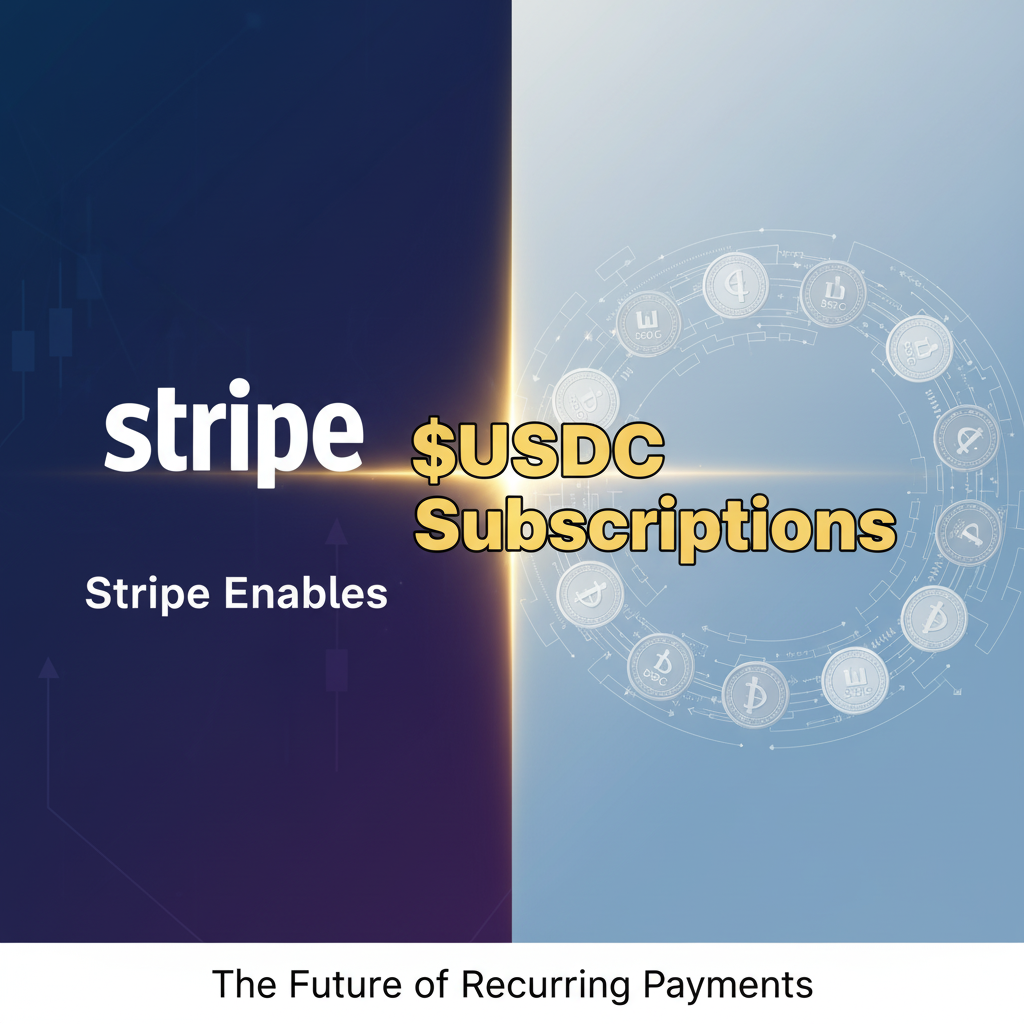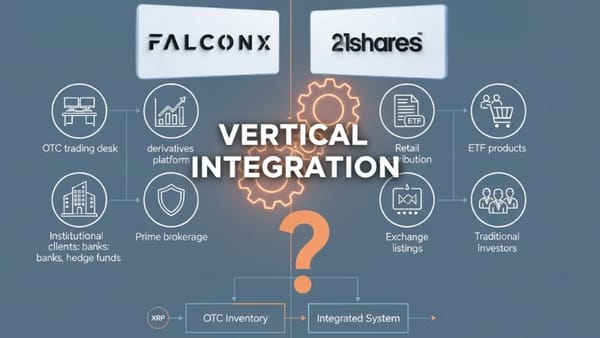Stripe Expands Crypto Integration with Stablecoin Subscription Payments
Stripe expands its crypto integration with stablecoin subscription payments, enabling businesses to accept recurring crypto payments. The move marks a major milestone in mainstream adoption as the $282B stablecoin market continues explosive growth.

Payment processing giant Stripe has quietly expanded its stablecoin capabilities to include recurring subscription payments, marking a significant milestone in the mainstream adoption of cryptocurrency-based financial infrastructure. The feature, revealed through updated documentation on October 14, 2025, allows businesses to authorize recurring withdrawals from customers' crypto wallets using stablecoins, primarily USDC.
A Strategic Expansion of Crypto Services
Stripe's move to enable stablecoin subscriptions represents the latest chapter in the company's aggressive re-entry into the cryptocurrency space. Following its $1.1 billion acquisition of Bridge in late 2024, Stripe has systematically rolled out a comprehensive suite of crypto-enabled products throughout 2025.
The subscription payment feature builds on Stripe's existing stablecoin infrastructure. Currently, only US businesses can accept these payments, with all stablecoin transactions settling in the business's Stripe balance in USD. The system imposes customer transaction limits of $10,000 per transaction and $100,000 per month, providing a cautious but functional framework for recurring crypto payments.
When customers pay with stablecoins, they are redirected to crypto.stripe.com to connect their crypto wallet, select a currency, and choose a payment network. The platform then authorizes recurring withdrawals, streamlining what has traditionally been a complex process for both merchants and consumers.
The Broader Stablecoin Ecosystem
This development comes as the stablecoin market experiences explosive growth. As of October 2025, the total stablecoin market capitalization has reached approximately $282 billion, representing a tenfold increase from just $28 billion in 2020. Conservative projections from Citi forecast the market reaching $1.9 trillion by 2030, while more optimistic scenarios suggest up to $4 trillion.
In 2025, Stripe has launched multiple stablecoin-focused initiatives. In May, the company announced Stablecoin Financial Accounts, enabling businesses in 101 countries to hold dollar-denominated stablecoin balances and move money across both crypto and traditional financial rails. In September, Stripe unveiled Open Issuance, a platform allowing businesses to launch their own stablecoins with just a few lines of code, partnering with reserve managers including BlackRock, Fidelity Investments, and Superstate.
Additionally, Stripe is collaborating with crypto investment firm Paradigm to build Tempo, a payments-focused blockchain designed for high-throughput stablecoin transactions. Tempo aims to process 100,000 transactions per second with sub-second finality, featuring partners including Visa, Deutsche Bank, Shopify, and OpenAI.
Market Implications
The subscription payment functionality could prove transformative for the cryptocurrency ecosystem. Major platforms that use Stripe's payment infrastructure—including Slack, Squarespace, Notion, and Shopify—could potentially integrate stablecoin subscriptions, providing a significant onramp for mainstream crypto adoption.
"Stablecoins are room-temperature superconductors for financial services," Stripe co-founder Patrick Collison stated when announcing the Bridge acquisition, highlighting the company's conviction in the technology's potential to revolutionize global money movement.
The timing aligns with broader regulatory clarity. The US Congress passed the GENIUS Act in July 2025, establishing clear legal requirements for stablecoin issuance, oversight, and consumer protection. Under the legislation, stablecoins must be backed one-to-one with US dollars or Treasury securities, with issuers required to conduct monthly audits and follow anti-money laundering standards.
XRP and Ripple: Navigating New Competition
For XRP and Ripple, Stripe's aggressive expansion into stablecoins presents both challenges and opportunities. Ripple has long positioned XRP as a bridge currency for cross-border payments, competing directly in the space that Stripe, Circle, and Google are now targeting with purpose-built blockchain solutions.
Direct Competition Intensifies
Analysts have noted that Stripe's Tempo blockchain, alongside Circle's Arc and Google's Cloud Universal Ledger, could potentially redirect stablecoin payment volumes away from the XRP Ledger. Tempo's compatibility with the Ethereum Virtual Machine gives it immediate access to the largest developer ecosystem in crypto, potentially accelerating adoption among DeFi applications and payment platforms.
The competitive landscape becomes more complex when considering network effects. As these tech giants build integrated stablecoin ecosystems with major corporate partners, they create powerful moats that could limit XRP's institutional adoption potential.
Complementary Roles
However, the relationship between stablecoins and XRP may be more complementary than competitive. Ripple CEO Brad Garlinghouse has argued that stablecoins serve single-currency use cases well, but cross-border transactions still benefit from a bridge currency like XRP.
"Stablecoins address a single currency," Garlinghouse explained in a 2024 interview. "If you're cross-border, having a bridge currency versus a stablecoin has some advantages." He emphasized that XRP is designed for parties to hold for mere seconds during transactions, avoiding the peg stability risks that stablecoins face when held for extended periods.
Ripple's own RLUSD stablecoin, launched in 2024, demonstrates the company's strategy to participate in both markets. The dollar-backed stablecoin provides on and off-ramps for its cross-border payment solutions, while XRP continues to serve as the liquidity bridge between different currencies and assets.
Partnership Opportunities
Ripple maintains strong relationships with financial institutions across 80+ payout markets, representing over 90% of the global foreign exchange market. As Stripe and other platforms expand stablecoin infrastructure, opportunities exist for integration where XRP bridges liquidity gaps between different stablecoin ecosystems and jurisdictions.
The rapid expansion of the stablecoin market—growing at over 50% annually—suggests there is sufficient demand for multiple winners. Rather than a winner-take-all scenario, the future may see XRP, Stripe's infrastructure, and other solutions serving complementary roles in a multi-faceted global payment ecosystem.
Price and Adoption Outlook
For XRP's price potential, increased competition could moderate growth expectations compared to a scenario where Ripple dominated institutional payments alone. However, growing institutional legitimacy for crypto payments infrastructure generally benefits the entire sector. If regulatory frameworks continue clarifying and major corporations adopt blockchain-based payments, XRP stands to benefit from the rising tide—even if it captures a smaller percentage of a much larger market.
The key question for XRP investors is whether Ripple can maintain its competitive advantages—including established banking relationships, regulatory compliance expertise, and the XRP Ledger's unique capabilities—as tech giants enter the space. The company's expansion into custody services, stablecoin issuance, and real-world asset infrastructure suggests a strategy focused on becoming indispensable across multiple layers of the digital asset ecosystem rather than relying solely on XRP as a bridge currency.
Looking Ahead
Stripe's stablecoin subscription feature, while currently in pilot mode, signals the beginning of a broader transformation in how digital payments operate. By enabling recurring crypto payments with the same ease as traditional subscription models, Stripe is removing friction that has historically prevented mainstream adoption.
The implications extend beyond consumer convenience. For merchants, stablecoin payments offer faster settlement, lower transaction fees for cross-border payments, and access to a global customer base that increasingly holds digital assets. The ability to hold stablecoin balances, convert between fiat currencies, and send funds internationally through a single platform creates powerful efficiencies for businesses operating in multiple markets.
As regulatory frameworks solidify and infrastructure matures, the distinction between "crypto payments" and "payments" may increasingly blur. Stripe's methodical integration of stablecoins into its core payment processing infrastructure—from one-time transactions to subscriptions, financial accounts, and custom stablecoin issuance—demonstrates that digital assets are moving from experimental technology to mainstream financial infrastructure.
For the cryptocurrency industry, this represents validation. For traditional financial services, it signals transformation. And for consumers and businesses globally, it promises faster, cheaper, and more accessible ways to move money across borders and between currencies.
DISCLAIMER: This newsletter is for informational purposes only and does not constitute investment advice, advertising, or a recommendation to buy, sell, or hold any securities. This content is not sponsored by or affiliated with any of the mentioned entities. Investments in cryptocurrencies or other financial assets carry significant risks, including the potential for total loss, extreme volatility, and regulatory uncertainty. Past performance is not indicative of future results. Always consult a qualified financial professional and conduct thorough research before making any investment decisions.
Sources
- Stripe Documentation - Stablecoin Payments
- Stripe Newsroom - Sessions 2025 Announcements
- Stripe Newsroom - Tour New York 2025
- Stripe Blog - Introducing Open Issuance from Bridge
- Stripe Blog - Introducing Stablecoin Financial Accounts
- Fortune - Stripe Stablecoins Open Issuance
- CoinDesk - Stripe Paradigm Unveil Tempo
- BeInCrypto - Stripe Stablecoin Subscription Payment
- American Banker - Stripe, Ripple and Circle Invest in Stablecoin Payments
- Visual Capitalist - Stablecoin Market Size Forecast
- CoinDesk - Stablecoin Market Cap Milestone
- Motley Fool - XRP Ripple Stablecoin Competition Analysis
- Ledger Insights - Ripple Stablecoin Launch Analysis
- Business Wire - Ripple USD-backed Stablecoin Announcement
- OneSafe Blog - Stablecoins and XRP in Modern Payments
- Bitcoin Ethereum News - Ripple Payments Demo



